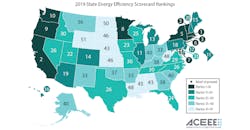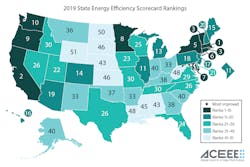ACEEE Annual Scorecard Reveals States Are Ramping Up Clean Energy
A rising number of states are showing U.S. leadership on clean energy by adopting ambitious goals and energy-saving rules for buildings, appliances, and vehicles, according to the 2019 State Energy Efficiency Scorecard, which was recently released by the nonprofit American Council for an Energy-Efficient Economy (ACEEE). The 13th annual report identifies the leaders — Massachusetts and California; the most-improved states, notably Maryland; the states that lost ground, such as Kentucky; and those lagging, including North Dakota and Wyoming.
The 50-state scorecard reveals increasing state commitment to energy efficiency. Nevada, New Mexico, Washington, New York, and Maine passed 100% clean energy goals, along with plans to increase efficiency investment. A record number of states adopted new efficiency standards for a variety of products and equipment. States have also countered the federal plan to weaken vehicle efficiency by promoting electric vehicles and adopting California’s vehicle emissions standards.
The scorecard, which ranks states on 33 metrics in six policy areas, found that some states are moving backward but most are stepping forward:
• Maryland improved the most since the 2018 Scorecard, moving up three spots to seventh place and gaining 4.5 (out of a possible total 50) points. The state made significant gains by focusing on utility efficiency programs, stronger building energy codes, public transit funding, and electric vehicle adoption. Hawaii also improved considerably, gaining 2.5 points, thanks in part to a new law that sets efficiency standards for products not covered at the federal level, including computers, faucets, and showerheads.
• Massachusetts ranked first for the ninth year in a row. Earlier this year, its regulators approved a new three-year efficiency plan with expanded programs that aim to reduce statewide greenhouse gas (GHG) emissions 80% by 2050. California, a close second, remains a national leader, setting tailpipe emissions and appliance standards that other states have adopted. Rounding out the top 10 are Rhode Island, Vermont, New York, Connecticut, Maryland, Minnesota, Oregon, and Washington.
• New York and New Jersey are states to watch because of their robust clean energy goals and focus on efficiency. Their utilities and regulators continue to strengthen efficiency programs to meet new savings targets approved last year. New York adopted one of the most aggressive U.S. climate targets, aiming to slash energy consumption 185 trillion Btu by 2025 and achieve 100% carbon-free electricity by 2040. New Jersey, which officially rejoined the Regional Greenhouse Gas Initiative in June, has a first-of-its-kind state partnership to promote electric vehicles.
• Ohio, in contrast, fell in the rankings. It enacted a law this year that attempts to save the state’s aging power plants but guts energy efficiency and renewable energy standards.
• Kentucky fell the furthest in the rankings, dropping from No. 29 to No. 38 and losing 4.5 points, due to a 2018 decision that discontinued most of the consumer-facing management programs for a key state utility, Kentucky Power. Other utilities in the state have also seen major cuts to their program funding.
From coast to coast, states are taking a concerted effort to promote electric vehicles, efficient products, smart buildings, cold climate heat pumps, and zero-energy building codes:
• Appliance standards. Four states — Washington, Colorado, Hawaii, and Nevada — adopted new laws to require products to meet minimum energy efficiency standards, and an additional six states and Washington, DC, filed similar bills. The standards passed this year are expected to save consumers hundreds of millions of dollars on their utility bills. The laws in Washington, Colorado, and Nevada include provisions to keep the federal light bulb standards that the U.S. government has announced it will roll back.
• Building energy codes and performance standards. States continue to update and strengthen codes for residential and commercial buildings. Since the publication of the 2018 International Energy Conservation Code, Maryland, Massachusetts, Nebraska, Illinois, and Ohio have adopted the updated codes and numerous other states are considering adopting them as well. Nebraska, which had not updated its building codes since 2009, now has the strongest codes in the Midwest. Some states are also moving toward building performance standards for existing commercial buildings. For example, this year Washington passed HB 1257, calling for energy use intensity targets for commercial buildings exceeding 50,000 sq ft.
• Vehicle efficiency. Thirteen states plus the District of Columbia have adopted California’s strict vehicle emissions standards, which the U.S. government recently announced it will no longer allow. Colorado is the most recent state to adopt these standards, finalizing its rule in November 2018. Nine states, including Massachusetts, Oregon, and Vermont as well as Washington, D.C., have also adopted its Zero Emission Vehicle programs, as well as overall goals to reduce vehicle miles traveled and the resulting emissions.
• Energy-saving targets. Several states, including Colorado, Maine, Massachusetts, New Jersey, New Mexico, New York, and Nevada, have renewed, extended, or strengthened energy-efficiency targets for utilities and statewide programs to lay the groundwork for future savings.
The Scorecard awards a total of 50 points based on state policies and programs in six areas: utilities, buildings, transportation, state government, combined heat and power, and appliance standards. It highlights best practices for promoting energy efficiency, typically the lowest-cost way to meet customers’ energy needs.
To download the report, click here.

